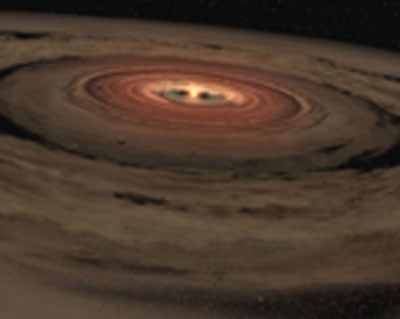The young Sun likely experienced a series of outbursts caused by the rapid infall of disk gas. The leading mechanism for explaining such outbursts is a temporary phase of disk instability. The researchers modeled the trajectories of several hundred centimeter-sized melilite mineral particles during such a phase. These particles are similar to calcium-aluminum-rich inclusions (CAIs), the refractory particles often found in well-preserved meteorites, as well as Comet 81P/Wild.
Their disk model assumed a gravitationally unstable three-dimensional disk with a mass of about 5 percent of today’s Sun and temperatures ranging from a frigid -350° Fahrenheit (-210 Celsius) in the outer regions to a scorching 2240° F (1230° C) near the center. Their calculations allowed the CAIs to orbit in the disk while being subjected to gas drag and the gravity of both the disk and the Sun.
The particles started orbiting in unison, but after about 20 years their trajectories began to diverge significantly. Most struck the inner boundary of the disk at 1 astronomical unit (AU, the Earth/Sun distance), while others went to the outer boundary at 10 AU where they could be swept up in a growing comet. About 10 percent migrated back and forth in the disk before hitting one of the two boundaries.
The researchers then modeled the evaporation and condensation processes that the particles would experience during their migrations. They found that such particles were likely to acquire outer rims with varied compositions recently shown to indicate CAIs.
“CAIs are thought to have formed at the very beginning of the solar system,” said Alexander. “Our results show that they must have experienced remarkably complex histories as they were transported chaotically all over the disk.”
These migrations could explain the different oxygen isotopes that have been found in particles from meteorites. These are varieties of oxygen atoms with different numbers of neutrons that point to different processing conditions for the particle rims.
Previous work by Boss had shown that oxygen isotope abundances could vary in an unstable disk, resulting in the range found in meteorites. Coupled with the new results, these models show that several puzzles may have been solved: an unstable disk can explain both large-scale outward transport of refractory particles, as well as the peculiar rim compositions acquired during their journeys.
“It’s nice to solve two problems at once,” said Boss. “But there are still many more puzzles about meteorites for us to work on.”










